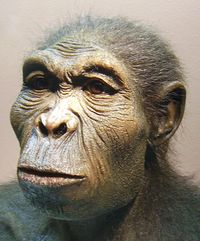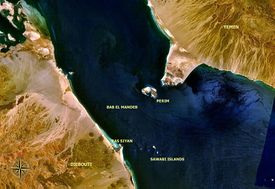الخروج الأول من أفريقيا
In paleoanthropology, Out of Africa I is the first series of hominin expansions into Eurasia, which took place from 1.8 to 0.8 million years ago (Ma). Shortly before in Africa, Homo erectus had descended from the woodland-restricted Homo habilis. H. erectus, diverging from H. habilis, adapted to the open grounds of the savannahs and arid landscapes, and later managed to expand out of East Africa, eventually into Eurasia.
According to the recent African origin of modern humans hypothesis (Out of Africa II), anatomically modern humans started moving into Eurasia c. 100,000 years ago, replacing the early hominins they found there from the earlier migrations. (Out of Africa usually[بحاجة لمصدر] means Out of Africa II, the expansion of modern humans into Eurasia.)
Early hominins moved out of Africa in at least three waves. Primitive chopper producers were first out by c. 1.8 Ma, followed by early Acheulean industries c. 1.4 Ma, and various cleaver-producing Acheulean groups around 0.8 Ma.[1]
Until the early 1980s, hominins were thought to have been restricted to the African continent in the Early Pleistocene, or until about 0.8 Ma; thus, archaeological efforts have been disproportionately focused on (East) Africa. Further, hominin migrations out of East Africa were probably rare in the Early Pleistocene, leaving a record of events broken in space and time.[2] In general, archeological evidence does not fit simple theories of where the migrations took place and is insufficient to support elaborate conjectures.[3]
. . . . . . . . . . . . . . . . . . . . . . . . . . . . . . . . . . . . . . . . . . . . . . . . . . . . . . . . . . . . . . . . . . . . . . . . . . . . . . . . . . . . . . . . . . . . . . . . . . . . . . . . . . . . . . . . . . . . . . . . . . . . . . . . . . . . . . . . . . . . . . . . . . . . . . . . . . . . . . . . . . . . . . . .
المواقع
The oldest hominin sites are in East Africa. The earliest evidence for retouched tools is from Kada Gona, Ethiopia, and dates back to 2.6 – 2.5 Ma in the very early Pleistocene. They might be the product of Australopithecus garhi or Paranthropus aethiopicus, the two known hominins contemporary with the tools.[4]
طرق الخروج من أفريقيا
شبه جزيرة سيناء
باب المندب
مضيق جبل طارق
مضيق صقلية
عبور المضائق
أسباب تفرق أشباه البشر
التغير المناخي ومرونة أشباه البشر
تعقب النبيت
علم أحياء أشباه البشر

Brain thermoregulation

Thermoregulation and dehydration are major problems that need to be dealt with to move into the open grasslands. In particular, vascularisation of the brain is crucial in maintaining it in the narrow frame of tolerable temperatures.
== المراجع ==
- ^ Bar-Yosef, O. & Belfer-Cohen, A. (2001). From Africa to Eurasia — early dispersals. Quaternary International, 75(1), 19–28. doi:10.1016/S1040-6182(00)00074-4
- ^ Lahr, M.M., 2010. “Saharan Corridors and Their Role in the Evolutionary Geography of ‘Out of Africa I’”. In: A. Baden et al. (Eds.), Out of Africa I: The First Hominin Colonization of Eurasia. Springer Netherlands, 27–46.
- ^ Straus, L. G., & Bar-Yosef, O. (2001). “Out of Africa in the Pleistocene: an introduction”. Quaternary International 75(1), 2–4.
- ^ Semaw, S. (2000). “The World’s Oldest Stone Artefacts from Gona, Ethiopia: Their Implications for Understanding Stone Technology and Patterns of Human Evolution Between 2·6–1·5 Million Years Ago”. Journal of Archaeological Science, 27(12), 1197–1214. doi:10.1006/jasc.1999.0592
للاستزادة
- Antón, Susan C.; Swisher, Carl C., III (2004), "Early Dispersals of Homo from Africa", Annual Review of Anthropology 33: 271–96, doi:.
- Eudald Carbonell; Marina Mosquera; Xosé Pedro Rodríguez; José María Bermúdez de Castro; Francesc Burjachs; Jordi Rosell; Robert Sala; Josep Vallverdú (2008), "Eurasian Gates: The Earliest Human Dispersals", Journal of Anthropological Research 64 (2): 195–228, http://www.jstor.org/stable/20371223.
- Ciochon, Russell L. (2010), "Divorcing Hominins from the Stegodon–Ailuropoda Fauna: New Views on the Antiquity of Hominins in Asia", in John G. Fleagle et al. (eds), Out of Africa I: The First Hominin Colonization of Eurasia, Vertebrate Paleobiology and Paleoanthropology Series, Dordrecht: Springer, pp. 111–26, doi:, ISBN 978-90-481-9035-5. ISBN 978-90-481-9036-2 (online).
- Dennell, Robin (2009), The Palaeolithic Settlement of Asia, Cambridge World Archaeology, Cambridge: Cambridge University Press, ISBN 978-0-521-84866-4. ISBN 978-0-521-61310-1 (paperback).
- Dennell, Robin (2010), "'Out of Africa I': Current Problems and Future Prospects", in John G. Fleagle et al. (eds), Out of Africa I: The First Hominin Colonization of Eurasia, Vertebrate Paleobiology and Paleoanthropology Series, Dordrecht: Springer, pp. 247–74, doi:, ISBN 978-90-481-9035-5. ISBN 978-90-481-9036-2 (online).
- Rabett, Ryan J. (2012), Human Adaptation in the Asian Palaeolithic: Hominin Dispersal and Behaviour during the Late Quaternary, Cambridge: Cambridge University Press, ISBN 978-1-107-01829-7, http://books.google.com.hk/books?id=coFA6_r4PTUC.
- Zaim, Yahdi (2010), "Geological Evidence for the Earliest Appearance of Hominins in Indonesia", in John G. Fleagle et al. (eds), Out of Africa I: The First Hominin Colonization of Eurasia, Vertebrate Paleobiology and Paleoanthropology Series, Dordrecht: Springer, pp. 97–110, doi:, ISBN 978-90-481-9035-5. ISBN 978-90-481-9036-2 (online).
